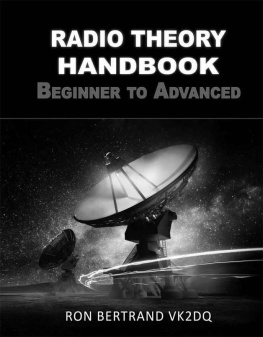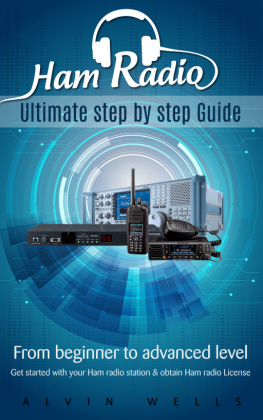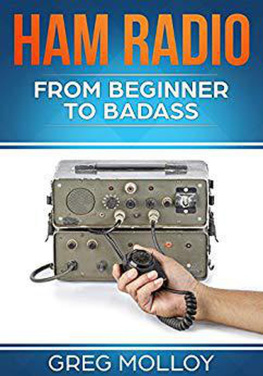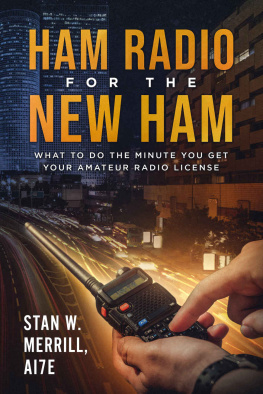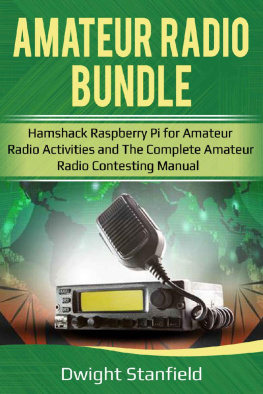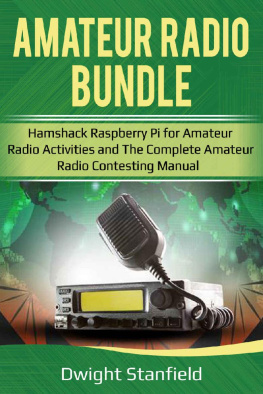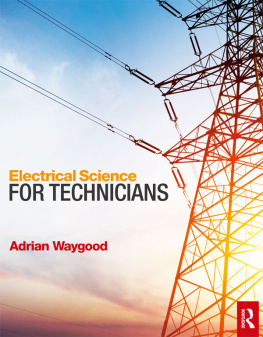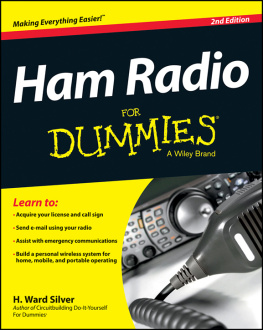Radio Theory Handbook
Beginner to Advanced
Ron. Bertrand VK2DQ
Copyright 2016 Ron. Bertrand
All rights reserved.
ISBN: 1534696121
ISBN-13: 978-1534696129
DEDICATION
The author extends a sincere gratitude to the Trainers, Students and Friends of the Radio & Electronics School for the assistance in producing this handbook. Without their input and gentle pushing this handbook may never have been produced.
Disclaimer of Liability
The material contain in this publication are supplied without guarantee. The author expressly disclaims all and any liability to any persons whatsoever in respect of anything done or omitted to be done by any such person in reliance either in whole or in part upon any contents of this publication. All rights reserved. R. Bertrand.
CONTENTS
1. Basic Electricity-Part 1
This book begins with the basics of electrical and radio theory and then progressively builds to a solid understanding of Advanced Amateur Radio Operator level as it applies to countries like Australia, U.K. USA and Canada. While starting at beginner level, the target standard of this book is CEPT Radio Experimenter Advanced Licence (T/R 61-01). It is imperative to have a thorough understanding of the fundamentals of electricity before any study of radio and communications. We start our study from the beginning, thus benefiting readers with a limited knowledge of the basics whilst also providing a convenient refresher for those who may have long since covered the material. Once we have the fundamentals down rock solid, we will progress to the Advanced Radio Theory.
ELECTRICITY
The complicated electronic systems involved in modern-day communication, satellites, nuclear power plants, radio and television and even up-to-date automobiles, do not require technicians to understand the functioning of electric and electronic circuits. Modern day electronics is very modular. A remove and replace, or substitution of the suspected faulty module is the approach to modern electronics servicing. This, in itself, is not a bad thing, as in the real world, getting an electronic device up and going is the most important thing. However, to have a true understanding requires a strong foundation in the basics of electricity. The term electronic infers circuits ranging from the first electronic device, the electron tube, to the newer solid-state devices such as diodes and transistors, as well as integrated circuits (ICs). The term electric or electrical is usually applied to systems or circuits in which electrons flow through wires but which involve no vacuum tubes or solid-state devices. Many modern electrical systems are now using electronic devices to control the electric current that flows in them.
What makes such a simple thing as an electric lamp glow? It is easy to pass the problem off with the statement, The switch connects the light to the power lines and it glows or something to that effect. But what does connecting the light to the power lines do? How does energy travel through solid copper wires? What makes a motor turn. A radio play? What is behind the dial that allows you to pick out one radio station from thousands of others operating at the same time? How fast is electricity? There are no single simple answers to any of these questions. Each question requires the understanding of many basic principles. By adding one basic idea to another, it is possible to answer, eventually, all of the questions that may be asked about the intriguing subjects of electricity, electronics and radio.
When a light switch is turned on and elsewhere the light suddenly glows, energy has found a path through the switch to the light. The path used is usually along copper wires and the tiny particles that do the moving and carry the energy are called electrons. These electrons are important to anyone studying electronics and radio since they are usually the only particles that are considered to move in electric circuits.
To explain what is meant by an electron, it will be necessary to investigate more closely the makeup of all matter. The word matter means, in a general sense, anything that can be touched. It includes substances such as rubber, salt, wood, water, glass, copper and air. The whole world is made of different kinds of stuff. The ancient Greek philosophers were always trying to find the stuff that the universe was made of. Even before the Greeks, the Alchemists were trying to find the basic building blocks that all matter was made from, though most of the time their driving force was not so much science but the pursuit of wealth. They figured that if they could isolate the building blocks of matter, then they would be able to create matter themselves. One of their primary pursuits was the creation of the precious metal gold.
Water is one of the most common forms of stuff that we call matter. If a drop of water is divided in two and then divided again and again until it can be divided no longer and still be water, then we have arrived at the smallest possible piece of water. We have a water molecule. The ancient Greeks would have called the smallest droplet of water an atomos (atom). The word atomos means indivisible. We know today that substances such as water can be divided into more fundamental bits.
Figure 1-1
The water molecule can be broken down into still smaller particles, but these new particles will not be water. Physicists have found that three smaller particles make up a molecule of water. Two atoms of hydrogen (H) and one atom of oxygen (O) as shown in . The symbols H and O are universal symbols used to represent Hydrogen and Oxygen. Oxygen, at average temperatures, is one of the several gases that constitute the air we breathe. Hydrogen is also a gas in its natural state; it is found in everyday use as part of the gas used for heating or cooking. If a gaseous mixture containing two parts of hydrogen and one part of oxygen is ignited, a violent chemical reaction, an explosion, will occur as water is formed and excess energy released. This is not an experiment that I would recommend.
Water is made up of two atoms, hydrogen and oxygen. Water is a molecule. A molecule is a substance that is made up of groups of atoms. If you divided a droplet of water down to its smallest possible size, you would have a single molecule of water. If you had the means to split the water molecule further, you would no longer have water; you will have the atoms (hydrogen and oxygen) that make up water. The chemical name of water then is Di-Hydrogen Oxide. It has been found that atoms are also divisible. An atom is made up of at least two types of particles: protons and electrons and a third particle called a neutron. Dont let these names concern you too much. For our purposes, the primary particle is the electron, at this time. Electrons and protons are called electrical particles and neither one is divisible (in typical environments). All the molecules that make up all matter in the universe are composed of these electrical proton-electron pairs.
ELECTRONS AND PROTONS
Electrons are the smallest and lightest of the fundamental particles. They are said to have a negative charge, meaning that they are surrounded by some invisible field of force that will react in an electrically negative manner with other matter.
Figure 2-1
Protons are said to have a positive charge and are surrounded by an invisible force field that causes them to react in an electrically positive manner. The words negative and positive are just names to describe the so-called charge of electrons and protons and their charge describes how they interact with each other. We could just as easily call the charge of the electron the
Next page
